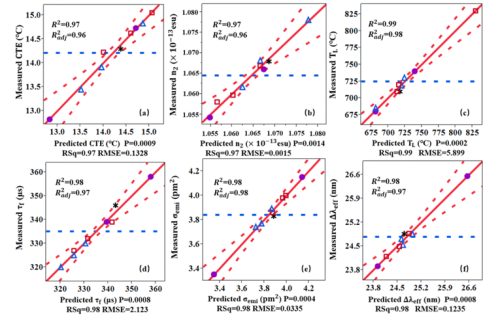The laboratory of high power laser optical components of Shanghai Institute of Optics and Fine Mechanics (SIOM) of the Chinese Academy of Sciences (CAS) proposed glass structure gene modeling (GSgM) can accurately simulate the properties or design the compositions of glass with limited data. Related research results were published in the Journal of Non-Crystalline Solids under the title " Genome-based approach to new Nd: Phosphate glass: Composition-structure-property statistical modeling and validation " on November 04, 2022.
Neodymium-doped phosphate laser glass (Nd: glass) has long been studied as a gain medium in high-power laser systems because of its wide adjustable range of spectroscopic properties. The high-power and high-energy laser system requires higher performance in terms of the thermo-mechanical, spectroscopic, and anticrystallization properties of Nd: glass. Usually, a design methodology for a commercial laser glass is to fine tune the candidate composition within a narrow range to achieve gradual property improvements. The process is inefficient, i.e., higher costs and a prolonged development cycle. Accurate and rapid material design method is the key to shorten the research cycle and accelerate the practical process of new materials.
The research team used a baseline Nd:phosphate glass and investigated effects of K2O, MgO, and Al2O3 on optical properties (σemi,τf, Δλeff, n2), coefficient of thermal expansion (CTE), and TL, which was carried out in conjunction with glass structure analysis using Fourier transform infrared (FTIR) technique. Through mathematical statistical analysis, the most closely related structural units are selected to establish the structure-property (S-P) and composition-structure (C-S) model. The prediction accuracy of the model for all properties is ideal, and the correlation coefficient is R2 > 0.97, Radj2 > 0.95. At the same time, the P value (< 0.005) indicates that the model has good convergence. Then, the C-S-P simulation platform (glass structure gene simulation method GSgM) is constructed by combining S-P and C-S models, which can realize the bi-directional prediction of compositions and properties. GSgM validation tests were performed by using “bi-directional” modeling steps, P→S→C and C→S→P. The former is to design specific glass genes to meet the target properties, the models satisfactorily match with the experimental results with the less than 0.4% relative error. The latter is predicting the properties of the designed glass, the relative errors in most cases were within 0.5%, except for τf close to 1.73%.
The use of GSgM methodology moves away from the conventional C-P approach to new glass design and offers more flexibility in handling highly nonlinear glass property response to composition variations, which enable a researcher designing new glasses starting from the selection of specific glass structure groups to meet a set of property requirements (or glass composition) all at once and subsequently defining the final glass composition or predicting glass properties.

Fig. 1. Measured (gray lines) and curve-fitting (red lines) derived IR spectra of BL, PK2, PM2, and PAl2 glasses (spectra are shifted vertically for clarity), in which individual bands (blue lines) are shown for BL glass with the residual (ΔI) between the simulated and measured spectrum. (Image by SIOM)

Fig. 2. S-P models: CTE, n2, TL, τf, σemi, and Δλeff. (Image by SIOM)

Fig. 3. P→S→C modeling procedure in designing new glass composition. (Image by SIOM).
Article website:
https://doi.org/10.1016/j.jnoncrysol.2022.121988
Contact:
WU Xiufeng
General Administrative Office
Shanghai Institute of Optics and Fine Mechanics, CAS
Email: xfwu@siom.ac.cn
Web: http://english.siom.cas.cn/